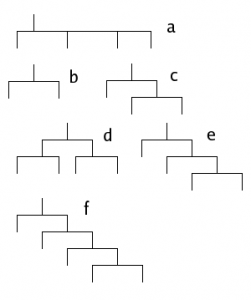We all know how planets orbit the Sun in our own Solar System. But what is going on in a planetary system that includes a group of stars and a handful of planets? (read more about these monstrosities in our previous space blog “Planets in multiple star systems”) Are you already imagining a swarm of stars moving like Brownian particles with planets zooming past in a figure-of-eight manner? Because we are!
There are indeed some planets orbiting their host stars in a such a fashion. Unfortunately the figure of eight and other kinds of exotic orbits are very unstable and things usually end badly for stars and planets involved. “Kick-out-of the system-or-crush” kind of badly. Ouch!
Then how DO planets and stars orbit in a multiple star system?
-
Binaries with planets
Let’s look at the simplest example of a binary system.
In a binary two stars orbit around the common center of mass. That’s simple. If a binary have a planet, then two types of configurations are possible (this short video will illustrate both possibilities):
- A planet orbits one of the stars in the system. Then we say it’s a circumstellar planet or a planet with S-type orbit. In S-type systems we usually see a wide binary (i.e. the two stars are quite far away from one another) and planet orbits relatively close to one of the stars.
- A planet orbits both stars. Then we say it’s a circumbinary planet or a planet with p-type orbit. In p-type systems two stars are close together. The planet orbits the star system at a distance greater than the separation between the two stars. The first confirmed circumbinary planet is Kepler 16b in the constellation Cygnus the Swan, 245 light years away from us. It lies just within its star system’s Goldilocks zone but is unlikely to be habitable. Oh no…:(
-
Triple and higher order multi-star systems with planets
If there is more than two stars in a multi-star system, they will be organized in a “hierarchical way” i.e. as “nested binaries”.
*There is another, chaotic type of star arrangement called trapezia, but it is quite unstable and therefore not interesting for us at the moment.
In case of a triple star system “hierarchical way” means that there is a close binary orbited by another star. Hierarchical arrangements of higher order are illustrated on the “mobile diagram” below (it does look like a ceiling mobile, doesn’t it?). “Hierarchy” here refers to a number of layers on a diagram.

Mobile diagram:
b) binary
c) triple star system
d), e), f) four star system
If we now add planets to the multi-star system, the situation will get even more complicated. But just as with binaries, the planets will have the same choice of orbits and will be either circumstellar or circumbinary.
Stable orbits
We have to remember, that although there are different ways to group together a few stars and a planet (or planets), in each case there will only be a small region where the orbit of the planet will remain stable (i.e. the planet will not crush into one of the stars and will not be slingshot out of the system). For example, if a circumstellar planet is too far from its host star, than the gravity of the stellar companion(s) will disturb the planet’s orbit. And the consequences might be catastrophic! The same will happen if a circumbinary planet orbits its stars a bit too close.
Many theoretical studies have been done recently to address the issue of the orbital stability in various planetary configurations. To understand where to look for exoplanets in a multi-star system, astronomers perform numerical simulations. They “play” with different parameters, like masses, mutual distances, orbital eccentricities (that is how round or how squashed the orbit is) and inclinations (that’s the tilt of the orbit) and try to see which combinations lead to stable planetary systems. When astronomers have the right numbers, they can create “maps” of stability regions for different planetary configurations!
What is that for, you may ask?
Well, the next step is to look at the real observations of multi-star systems and compare them to the theoretical “maps”. This way we can predict the existence of yet undetected planets! And sometimes even tell what method of observation we can use to have the best chances of finding it! How cool is that?
Finally, let’s see what kind of planetary orbits we observe in multi-star systems!
Observations
- Most exoplanets we see in multi-star systems are circumstellar and only few are circumbinary. The ratio is about 5:1.
- It looks like circumbinary planets occur as often as gas giants near Sun-like stars. There is apparent lack of planets near tight binaries.
- Small and short-period planets are rare among observed curcumbinaries. Although the tiniest one discovered is only three times bigger than the Earth!
There is still so much to learn and explore! Don’t you think?
If you want to do some more research on the topic, we would recommend the following papers:
Stability of planets in triple star systems
Dynamical origin of S-type planets in close binary stars
If you have any questions or comments please let our inflatable planetarium team know!

